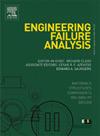近海石油平台火炬系统 AISI 316L 管道的故障调查
IF 4.4
2区 工程技术
Q1 ENGINEERING, MECHANICAL
引用次数: 0
摘要
石油和天然气行业的作业条件十分恶劣,导致海上设备多次发生故障。火炬系统是一种管道,设计用于在启动、运行中断、紧急停机和维护活动期间安全处理释放的碳氢化合物气体和液体。这项工作报告了高压火炬系统管道的故障调查。根据设备数据表,该管道直径为 220 毫米,厚度为 4 毫米,材质为 AISI 316L 不锈钢。在之前的无损检测中发现了两条裂缝。这些故障已经修复,但几个月后又发现了另一条裂缝。使用光学发射光谱和元素分析对化学成分进行了调查,结果与 AISI 316L 不锈钢相符。用光学显微镜和扫描电子显微镜观察到的微观结构显示出带有变形带的奥氏体基体。显微硬度测量和 XRD 分析表明,在这些变形带中形成了马氏体。拉伸性能符合标准。使用扫描电子显微镜对断裂表面进行了研究,结果表明其存在疲劳破坏。本文章由计算机程序翻译,如有差异,请以英文原文为准。
Failure investigation of an AISI 316L pipe of the flare system in an off-shore oil platform
The oil and gas industries have severe operations conditions, which impose several failures in off-shore equipment. The Flare System is a pipe designed to safely dispose of relieving hydrocarbon gases and liquids during start-up, operational upsets, emergency shutdown, and maintenance activities. This work reported the failure investigation in a pipe of a high-pressure flare system. The pipe has a diameter of 220 mm and 4 mm of thickness, and according to the equipment datasheet, it was made in AISI 316L stainless steel. Two cracks were detected during the previous non-destructive inspection. Those failures were repaired, but another crack was detected after some months. Chemical composition was investigated using optical emission spectroscopy and elemental analysis, and the results are compatible with AISI 316L steel. The microstructure observed by light optical and scanning electron microscopes shows an austenitic matrix with deformation bands. The microhardness measurements and the XRD analysis show the martensite formation in those deformation bands. The tensile properties are in accordance with the standards. The fracture surface was investigated using scanning electron microscopy, the results point to fatigue failure.
求助全文
通过发布文献求助,成功后即可免费获取论文全文。
去求助
来源期刊

Engineering Failure Analysis
工程技术-材料科学:表征与测试
CiteScore
7.70
自引率
20.00%
发文量
956
审稿时长
47 days
期刊介绍:
Engineering Failure Analysis publishes research papers describing the analysis of engineering failures and related studies.
Papers relating to the structure, properties and behaviour of engineering materials are encouraged, particularly those which also involve the detailed application of materials parameters to problems in engineering structures, components and design. In addition to the area of materials engineering, the interacting fields of mechanical, manufacturing, aeronautical, civil, chemical, corrosion and design engineering are considered relevant. Activity should be directed at analysing engineering failures and carrying out research to help reduce the incidences of failures and to extend the operating horizons of engineering materials.
Emphasis is placed on the mechanical properties of materials and their behaviour when influenced by structure, process and environment. Metallic, polymeric, ceramic and natural materials are all included and the application of these materials to real engineering situations should be emphasised. The use of a case-study based approach is also encouraged.
Engineering Failure Analysis provides essential reference material and critical feedback into the design process thereby contributing to the prevention of engineering failures in the future. All submissions will be subject to peer review from leading experts in the field.
 求助内容:
求助内容: 应助结果提醒方式:
应助结果提醒方式:


